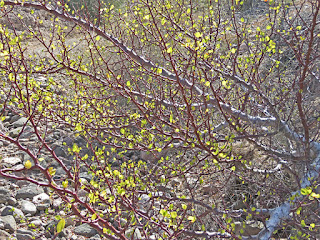The La Paz,
Baja California Sur area is chock full of birds, thanks to the large, shallow
bay and regular tides, as well as irrigated fields and a set of smelly sewage
ponds. We spent all morning working our way around the Ensenada, ending at the
ponds. There were no stake-out rarities this year, but past years have seen things
like Terek Sandpiper, Wood Sandpiper, and Red-throated Pipit in this area. We
had fun looking at the thousands of regular birds here anyway, the most
abundant being Western Sandpiper.
There were a
few American Oystercatchers, and I’m still waiting to hear from a local
ornithologist about the band on this bird.
I didn’t
take many photos of the many herons, egrets, and ibis, but this one Green Heron
was particularly unwary and in amazing light.
Magnificent
Frigatebirds were almost always visible overhead.
Or even
perched on power lines.
We birded
near some mangroves (there are three species together here). This is Avicennia
germinans, Black Mangrove, which is now in the family Acanthaceae. (Other
mangroves are actually in unrelated families).
This is of
course where we would find the Mangrove Yellow Warbler. Looking and sounding
very different from Northern Yellow Warblers and with a completely disjunct
breeding range and habitat (overlapping only in the winter), it remains a puzzle as
to why these two are considered the same species by the AOU. Even the females
look different.
There were
quite a few birds right along the waterfront in downtown La Paz, right across
the street from our hotel.
Western
Willet and Marbled Godwit
Yellow-footed
Gull, an endemic of the Gulf of California
Turkey
Vulture
This is Ammospermophilus leucurus, White-tailed
Antelope Squirrel, one of three land mammals we saw on the tour (the others
were Black-tailed Jackrabbit and Coyote).
I took this
photo of an Orthemis ferruginea,
Roseate Skimmer female at the sewage ponds to show my participants the little
flanges on either side of the abdomen near the distal tip. They are probably
used to scoop up droplets of water as they lay eggs and flick them onto the
shore.
There were
big flocks of Black-necked Stilts at the sewage ponds.
On our
second morning at La Paz, before our long afternoon drive north to Puerto San
Carlos, we explored the deserts and shores to the north of town.
There was zero
movement of seabirds on the ocean, despite perfect visibility – sometimes we
see shearwaters or boobies, even if distant, but this time we saw only the occasional Double-crested Cormorant and Eared Grebe. We walked a bit of a beach where we
had this Snowy Plover and Semipalmated Plover.
My best
guess on this skeleton, given the location washed up on a beach, would be a
Yellow-bellied Sea Snake. I’ve never seen a live one.
It has been
quite cool this week, and perhaps this is why butterfly numbers have seemed quite low. This one is Apodemia mejicanus maxima, an endemic
subspecies of Mexican Metalmark.
This is Ascia monuste raza, an endemic
subspecies of Great Southern White, and a new one for me.
As far as I can tell, this is the monotypic and widespread Erynnis funeralis, Funereal Duskywing.
The plants
in this coastal desert scrub are fascinating. This is Stenocereus thurberi, the same Organpipe Cactus that occurs in SW
Arizona.
This is a
sandmat, formerly in the genus Chamaesyce, but now in the huge, unwieldy genus Euphorbia – Euphorbia leucophylla.
This devilish looking cactus is Echinocereus brandegeei,
Brandegee's Hedgehog.
This
identity of this red-stemmed beauty has eluded me, but I suspect it’s a Jatropha species.
This Jacquemontia eastwoodiana, Island
Felt-leaf Morning-glory, was growing in a bush-like form. Later I saw one
growing more like a vine up into a tree.
The white
trunks of Lysiloma candidum, Palo
Blanco, give the woodland along the arroyos a distinctive look.
Lunch was next
to our hotel, and I had the delicious fried snapper, pargo frito, before we made the
long drive north to Puerto San Carlos.

































Rich Iam Joe Koutney from Portland OR. You visited us ( Tom passed away 6 years ago). I am interested in birding with you and want to know up coming trips. Drop a line Thanks
ReplyDelete